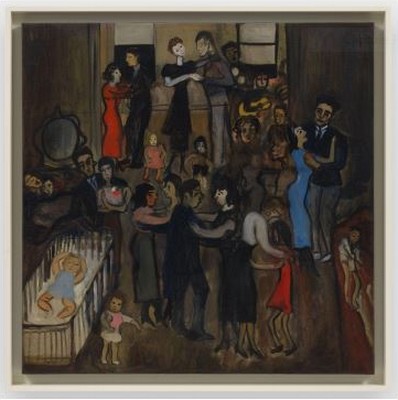Alice Neel: The Early Years
David Zwirner, New York
September 9 — October 16, 2021
Spanish Party, 1939
© The Estate of Alice Neel
Courtesy The Estate of Alice Neel and David Zwirner
I paint to try to reveal the struggle, tragedy and joy of life.—Alice Neel1
David Zwirner presents an exhibition of paintings and works on paper by ALICE NEEL (1900–1984) from the first decades of the artist’s influential career. The focused presentation centers on works from the 1930s through the 1950s, and includes interiors, memory paintings, New York City streetscapes, and portraits of family and others close to Alice Neel. At turns atmospheric, somber, and deeply personal, these works offer a chronological account of this significant period of Alice Neel’s life and work, and engage themes of interiority, intimacy, and the negotiation between private and public, which continue to resonate in our present moment. The Early Years is curated by gallery Senior Partner Bellatrix Hubert and Ginny Neel.
Painted from life and from memory in New York—first in Greenwich Village, and later in Spanish Harlem, where Alice Neel lived until 1962 before moving to the Upper West Side—the works in the exhibition examine the foundational decades of Alice Neel’s career, when she was struggling as an artist and mother during a time of social and economic upheaval and change. They reflect her commitment to figuration while abstraction was ascendant as well as her sensitivity and compassion toward her subjects. She is now widely acknowledged as one of the foremost American artists of the twentieth century, and these canvases and drawings register an introspective mood and the early personal struggles Alice Neel faced.
The exhibition includes the evolving cityscapes and street views that reveal the grit and resilience of New York, where Alice Neel lived from the late 1920s until her death in 1984. Capturing the Depression era, her social-realist compositions from the 1930s show the economic conditions and disparities that permeated the city. In Under Brooklyn Bridge (1932), Alice Neel features men going about their work on an otherwise empty lower Manhattan street. The Cafeteria (1938) juxtaposes a haggard older woman with a youthful figure in evening finery seated beside her, as a waiter clears the table behind them. Alice Neel likewise presents the thrills of metropolitan life. The dreamlike Movie Lobby (1932), painted from memory, shows two women seen from a distance, arm in arm and enjoying a night out on the town, surrounded by the swirl of pattern and texture of a movie theater interior. In the atmospheric composition Spanish Party (1939), couples dance and children of all ages play at an apartment gathering in Spanish Harlem, where Alice Neel moved in 1938. Later images, such as the moonlit snowy scene depicted from life in Harlem Nocturne (1952), evoke her emotional connection to her neighborhood.
Also on view are canvases that reveal significant personal and emotional moments Neel experienced in her life. These include Alice and Her Child (1930), a rare self-portrait in which the artist is shown cradling a baby in a cemetery. Painted a few short years after the death of Alice Neel’s first daughter with Carlos Enríquez, Santillana, it memorializes her infant who died of diphtheria before her first birthday. The work’s setting, restrained color palette, overcast sky, and Alice Neel’s downturned eyes capture specific and universal feelings of maternal heartbreak and loss. The year in which the work was painted was a devastating one for the artist, Carlos Enríquez left her, taking their second daughter, Isabetta, with him to Cuba. Alice Neel suffered a nervous breakdown, which resulted in her hospitalization over the course of the next year. Dead Father (1946), another work painted from memory, was composed the day after her father’s funeral, and it presents his body in an open funeral casket, placing the viewer in the position of a mourner.
The exhibition features portraits of those closest to Alice Neel, including lovers, family members, friends, and intellectual peers. These are the works for which she is best known, and she would return to these subjects throughout her career. On view are a number of significant paintings of Alice Neel’s children that speak to the intertwined and at times conflicting roles she held of mother and working artist. Her studio was the home she shared with her sons, who are depicted as young children in their Spanish Harlem apartment in Christmas, Hartley and Richard (c. 1943–1944), a disquieting, domestic holiday scene. Another canvas, Sam and Hartley (c. 1945), shows her youngest son being clutched tightly by his father, the photographer and filmmaker Sam Brody, who was Alice Neel’s partner between 1940 and 1958. The image is pervaded by an emotional, tense atmosphere. Alice Neel’s portraits of her family form a kind of record of her personal sphere and chronicle her children’s maturation. Among the works on view are the artist’s tender portraits of Hartley and Richard as earnest teenagers in the 1950s, poised for adulthood.
Alice Neel: People Come First, a major traveling retrospective, is on view at The Metropolitan Museum of Art, New York, through August 1, 2021, and will subsequently travel to the Guggenheim Museum Bilbao (2021–2022) and Fine Arts Museums of San Francisco (2022). In 2022, Centre Georges Pompidou, Paris, will present Alice Neel: Un regard engagé.
The artist’s work is included in numerous museum collections internationally. David Zwirner has represented The Estate of Alice Neel since 2008, and the present exhibition marks the sixth solo exhibition of the artist’s work at the gallery.
1. Alice Neel, quoted in “The Art of Portraiture, in the Words of Four New York Artists,” The New York Times (October 31, 1976), p. D29.
DAVID ZWIRNER
537 West 20th Street, New York
Updated 09/10/2022

